“Solah Shringar” means 16 bridal adornments. It includes 16 steps that a woman should follow to enhance her embellishment from head to toe at the time of her wedding. Apart from ritualistic beliefs, this ritual has scientific reasons behind it. Read on to know all about the Solah Shringar of a Hindu Bride and the Sixteen Indian Bridal Adornments with the science behind them.
As per Hinduism, the bride is considered as Goddess Lakshmi who is the goddess of prosperity, fertility and beauty in Hinduism. The Solah Shringar is a celebration of this divine beauty as per Hindu mythology. Another reason is that in Hinduism, a woman is considered the embodiment of Shakti (Consort of Lord Shiva). This 16 shingar helps the woman to protect orifices and extremities and control the power that emanate from these body parts.
Indian Literature is full of descriptions of women adorning themselves with ornaments while the Shringar Rasa is a noteworthy topic in all Indian classical dance forms. In Bhanusimha Thakurer Padabali highlighting herself for a meeting with Krishna, Tagore’s Radha says:
Dress me with Pearls and Jewels
Decorate my forehead with Maang Tikka
My hair is spilling to the ground
Bind it with garlands of Champak
As per Hinduism, the bride is considered as Goddess Lakshmi who is the goddess of prosperity, fertility and beauty in Hinduism. The Solah Shringar is a celebration of this divine beauty as per Hindu mythology. Another reason is that in Hinduism, a woman is considered the embodiment of Shakti (Consort of Lord Shiva). This 16 shingar helps the woman to protect orifices and extremities and control the power that emanate from these body parts.
Indian Literature is full of descriptions of women adorning themselves with ornaments while the Shringar Rasa is a noteworthy topic in all Indian classical dance forms. In Bhanusimha Thakurer Padabali highlighting herself for a meeting with Krishna, Tagore’s Radha says:
Dress me with Pearls and Jewels
Decorate my forehead with Maang Tikka
My hair is spilling to the ground
Bind it with garlands of Champak
The Solah Shringar comprises of:
- Bindi
- Sindoor
- Maang Tikka
- Anjana or Kajal
- Nath or Nose ornament
- Necklace
- Earrings
- Henna / Mehendi
- Bangles
- Armlet
- Haathphool
- Hair accessories
- Waistband
- Ankle bracelet
- Perfume or scent
- Bridal dress
While some of these are not currently practiced by modern Indian woman, much on this list is still in demand.
Pre – Shringar i.e. The Divine Bath
Prior to adorning the bride with Solah Shringar, she is given a Holy Bath. The ceremony begins the application of aromatic oil applied to the bride’s hair. It is washed with a mix of herbs like Brahmi, Shikakai, Aloe vera, Bhringraj, Amla, etc. A paste of oil, milk, turmeric powder, sandalwood powder, and gram flour is mixed together and applied to the bride’s hands, arms, legs and face. This blend not only has antibacterial properties but also has a fragrance that lingers on her body while enhancing her radiance. An organic face and body scrub in India, this blend is called Ubtan. This homemade body scrub carries numerous benefits on the skin.
All the women sing, dance and tease the bride as she is applied Ubtan. The bride then moves to take a proper bath to wash off these herbs. As time evolves, many brides nowadays have beauticians for such big occasions.
1. Keshapasharachana
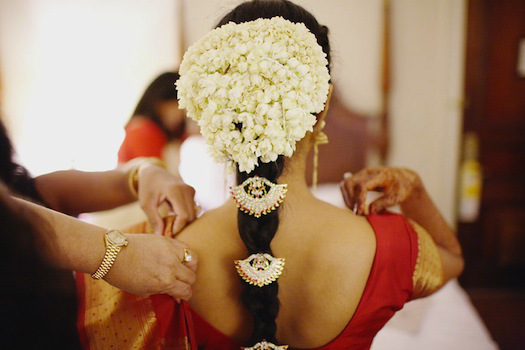
“Kesh” means hair, “Pash” means flock and “Rachna” means arrangement. After the bath, the hair is dried and decorated as per the latest style along with the bridal dress as per the tradition. The bride’s hair is styled and decked with jewelry and flowers. A string of flowers (Gajra) is worn both on the bun and the braid as a coiling.
Scientific reason – Jasmine is the queen of all flowers that stays fresh and carries long-lasting fragrance. It keeps the bride fresh all day.
2. Mang Tikka
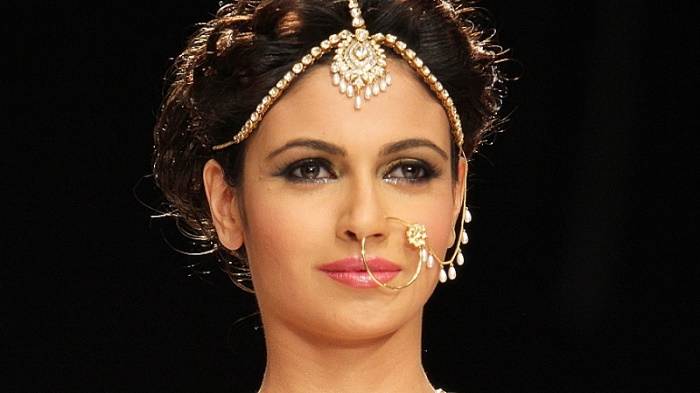
Also known as Bhor, Borla or Mang-patti, Mang Tikka is worn on the center parting of the hair that comes till the forehead. Another type of Mang Tikka has a chain that is tied along the hairline of the hair. It enhances the look of the bride.
Scientific reason – Mang Tikka is believed to control the body heat. Its placement at the center parting of the hair has a crucial scientific reason behind it. This is the point where the Ajna chakra is located which in Sanskrit means “to know or perceive”. The Chakra represents two petals that signify the holy union of man and woman on a spiritual, physical and emotional level.
3. Sindoor
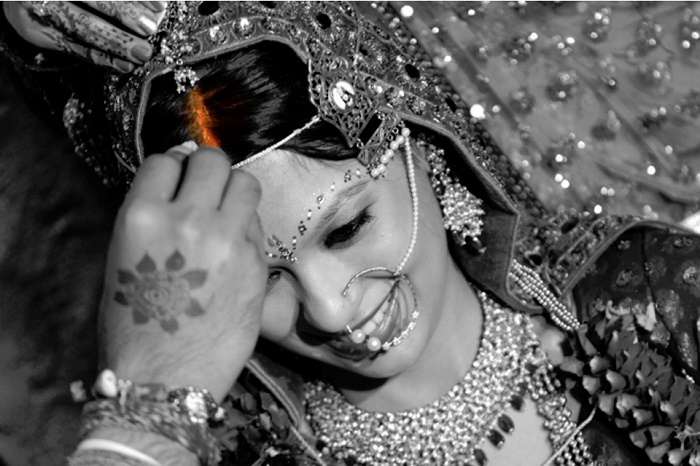
Sindoor or vermillion is a red-colored powder that is applied to the bride’s center hair partition. In fact, Sindoor is considered a sacred symbol of married women in India just like the wedding ring in Western cultures. During the wedding rituals, the groom puts Sindoor on the bride’s head. In some parts of Hindu culture, it is mandatory to wear Sindoor as it is believed that it will prolong the husband’s life.
Scientific reason – Made using turmeric, lime and a small amount of Mercury metal, Sindoor cools down the body and makes the bride feel relaxed. As the wife’s responsibilities increase, the stress can take a toll on the body. Wearing sindoor keeps her balanced and in control of her emotions. It is also known to trigger sexual drives in women. Hence, widows or unmarried women are prohibited to wear Sindoor.
4. Bindi

The Bindi is a sacred symbol of Hindu culture and is worn by both married as well as an unmarried woman. However, it is mandatory for a married woman to wear Bindi. Traditionally, Bindi was made using turmeric and other natural ingredients while nowadays sticker bindi designs are used to highlight one’s beauty. The Bindi also symbolizes the dedication of the wife towards her husband and their marital relationship.
Scientific reason – A major nerve point, the middle of the eyebrows is known to help increase Kundalini energy during meditation. This spot is called the ‘command center’ and is said to help the woman maintain her mental balance.
5. Kajal
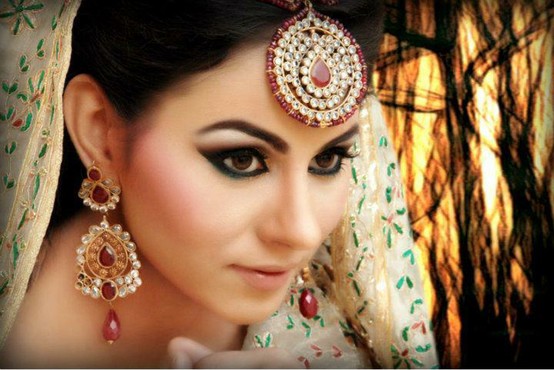
Kajal is a black eyeliner that accentuates the eyes and makes the bride even more beautiful. In olden times, Kajal was prepared using the soot of Diya (earthen lamp) lit with a wick placed in Ghee (clarified butter). With times changing, many women use black pencil eyeliner to get that Kohl look.
Scientific reason – The traditional and organic Kajal is known to protect the eyes and its parts. Natural kajal keeps the eyes active, glowing and reduces red spots.
6. Nose ring
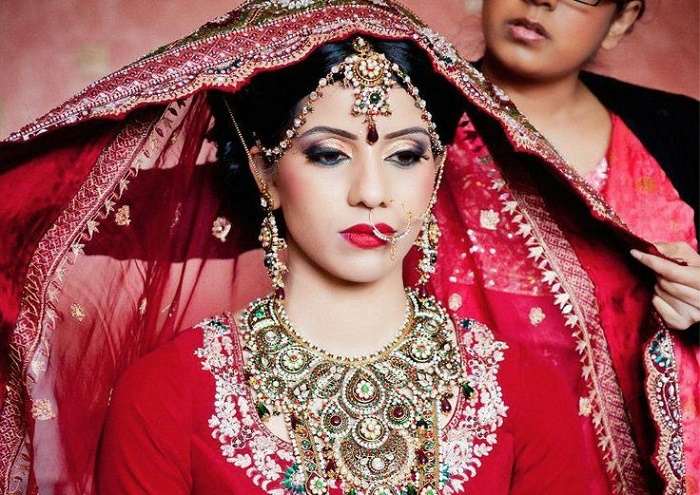
Known as Nath in Hindi, nose ring is one of the most traditional and ethnic wear in Indian culture. A nose ring features clusters of pearls, diamonds or any other gemstones that is worn in left nostril. In South India, however, it is worn on the right nostril. It is not removed and is a sign of a married woman. There are various nose ring designs available nowadays. One such design as seen in movies and TV serials are the big nose ring with a loop with a chain that extends behind the left/right ear.
Scientific reason – As per Ayurveda, a woman who gets her nose pierced eases menstrual and labor pains as it is connected to the reproductive organs.
7. Earrings
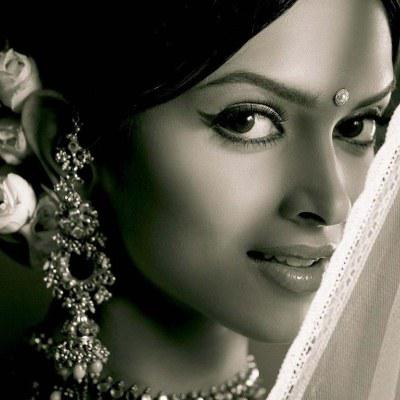
There are various earrings available. From Jhumkas to Chandbali (of Ram-Leela fame), women feel incomplete without earrings. Earrings or Karn Phool or Jhoomars feature elaborately decorated designs and the weight of these ornaments is supported by a chain that passes over the crown of the head. While some ornaments cover the entire ear, some hang from the lobe and end as a large pendant.
Scientific reason – Our ears have a lot of acupuncture and acupressure points. When you wear earrings, the acupuncture effect on the body cures menstrual problems and keeps bladder and kidney healthy and active.
8. Necklace and Mangalsutra
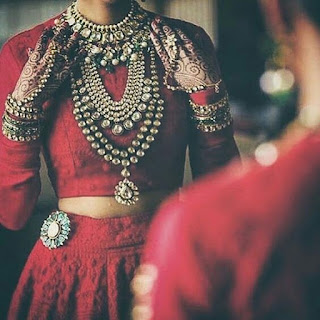
The Solah Shringar of a Hindu bride includes different styles of Necklace such as Choker that are strung with pearls, gold and gemstones. You will also find Floral necklaces that are worn by the bride. The most traditional Haar is the Mangalsutra that is given by the husband to the wife on the wedding day as a symbol of trust, commitment and eternal love.
Scientific reason – Necklaces such as Mangalsutra has significant role in the body as it controls blood pressure levels and improves blood circulation.
9. Baaju-band, Armlets or Armbands

The Baaju-band is usually seen in Rajasthani, Mughal and Jaipuri weddings. Worn on the upper arm, Armlets are made of pearls or diamonds that are encrusted in gold.
Scientific reason – The Armband helps in regulating the blood circulation of your arms and creates the right amount of resistance that keeps your arm relaxed.
10. Bangles
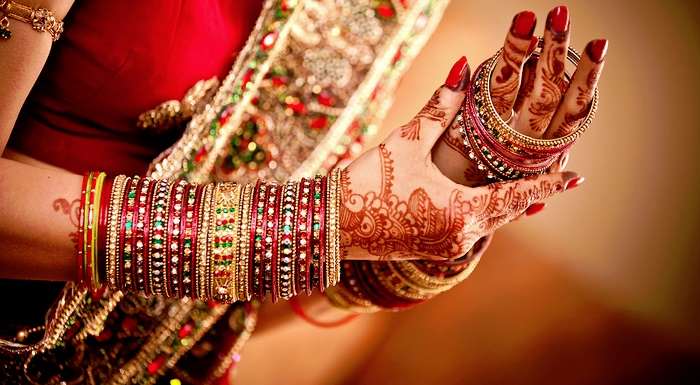
Called “Choodiyan” in Hindi, bangles are one of the Solah Shringar of a Hindu Bride. These bangles may be made of iron, ivory, green or red glass, ceramic, gold and any other metals as per the custom. Sikh and Punjabi brides add Kaleeras to the bangle set. It is said that a new bride should not be cooking and cleaning in the husband’s house when she first moves in. This is why she has all the bangles and Kaleeras on her hand.
Scientific reason – The sound of the bangles not only enhances the bride’s grace but also strengthens the bones of your hand. As per Ayurveda, the friction of the bangles with the hand, the properties of the metals enter the body efficiently.
11. Henna
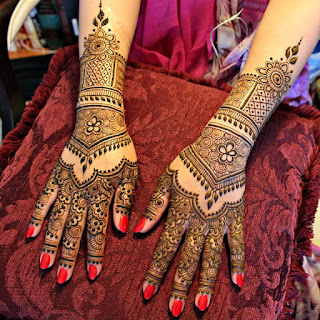
Henna has a cooling effect on the body that keeps the pre-wedding jitters and stress at bay. Apart from the scientific reason, the red color of the henna is considered auspicious as it has emotional, sexual and fertility-related qualities too. Redder the color of the Henna, stronger the bond between the bride and her husband as well as her mother-in-law. There are many Mehendi designs available that beautify the bride naturally.
Scientific reason – The medicinal properties of Henna helps in relaxing the nerves and fights off any stress. It is a fantastic cooling agent that keeps your body cool and helps in healing cuts and bruises on the body.
12. Rings and Hathphool

The bride wears eight rings on her hands that are attached with a central floral or a medallion design which covers her palmer side. This is called Hathphool. Of the Hathphool, three of the chains pass to a bracelet and five to each of the fingers where it is connected to the finger rings. As per the style, the left-hand thumb ring may contain a mirror called Aarsi.
Scientific reason – The rings on your fingers help in stimulating brain activity and is considered good for your health.
13. Aarsi
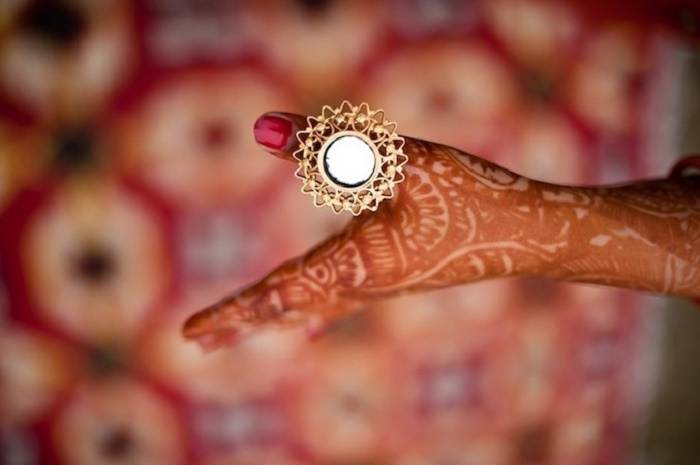
Aarsi is a thumb ring that features a mirror on it which enables her to have a look at herself as well as her husband during the wedding rituals. As the bride has to wear a veil around her head and face, she cannot see her partner. The Aarsi helps in getting a peek of the groom.
Scientific reason – Same benefits as above.
14. Waistband
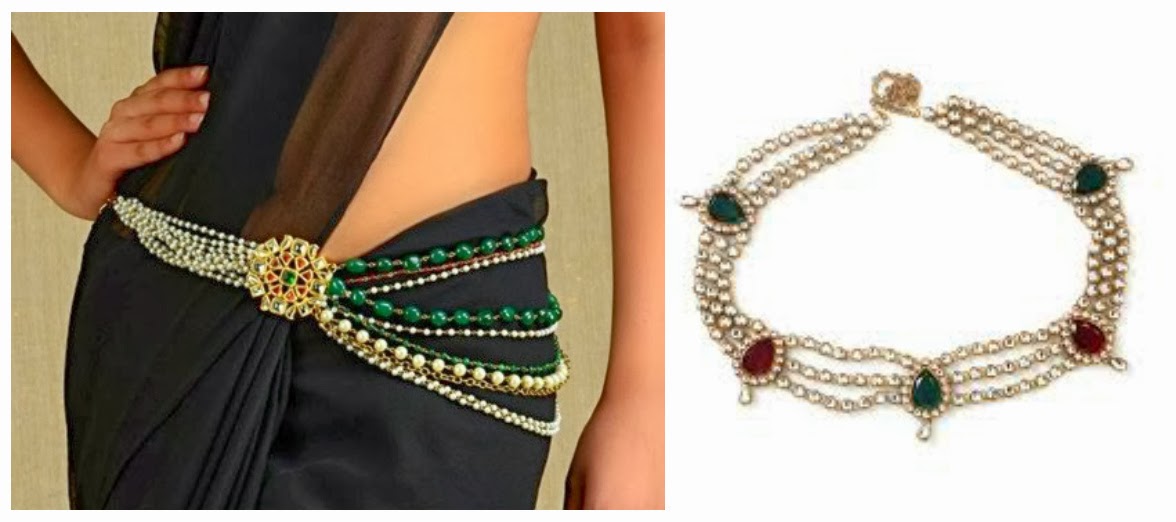
Known as Kamarband or Kardhani, the waistband is designed aesthetically in gold that is studded with precious gems. It not only holds the bridal wear in place but also accentuates the bridal figure effectively. It is also a great way to curb the excess tummy (in some brides) and make it look sleek and in shape.
Scientific reason – Worn on the hip, Kamarband helps in regulating the menstrual periods and provide relief from the menstrual cramps. Some people wear silver waistband that helps in controlling belly fat.
15. Ankle bracelets or Anklets

Called Payal in Hindi, Anklets are literally ankle bracelets that feature small bells attached to its ends. When worn on both feet, it makes a pleasant tinkling sound when the bride moves.
Scientific reason – Wearing anklets help in giving you relief from sciatica condition that causes pain, tingling and weakness in legs. It also regulates blood circulation and alleviates swollen heels. Wearing anklets activates the lymph glands in the body and boost the immune system. It is also known to cure menstrual diseases, fertility, hormonal imbalance and abnormal conditions of obstetrics.
16. Toe rings
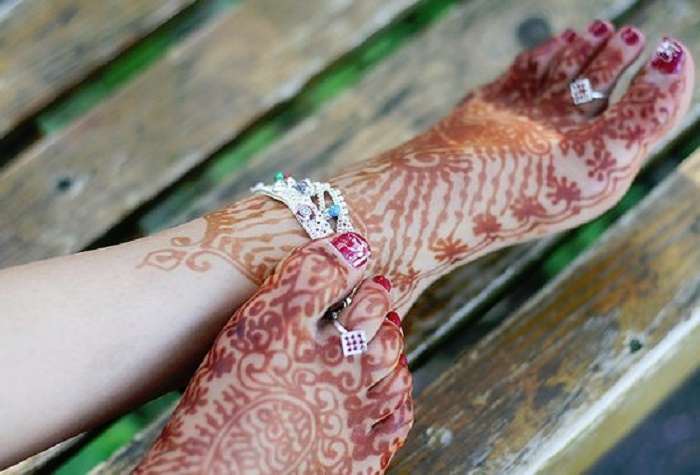
Traditionally, toe rings were simple, round bands that are to be worn in the middle toe of both feet. Today, there are various designs available online. You will find many floral designs as well as toe patterns designed like Hathphool.
Scientific reason – These classic toe rings are not only a symbol of marriage but are known to ease menstrual pains and increase chances of fertility. This is because the veins of the middle toe are connected to the fertility reproductive system.
Our Indian culture and traditions are vast since millions of years ago. Some people call it “stupid beliefs or blind superstitions” but we shouldn’t disregard it without understanding the pointers completely. The fact is that many of us are unaware of the real scientific reasons behind them.
Everything in our Indian culture is purely based on science. Observe closely and you will realize that every ritual and tradition give importance to physical and mental well-being. For your good well-being, it is safe to follow these traditions.
